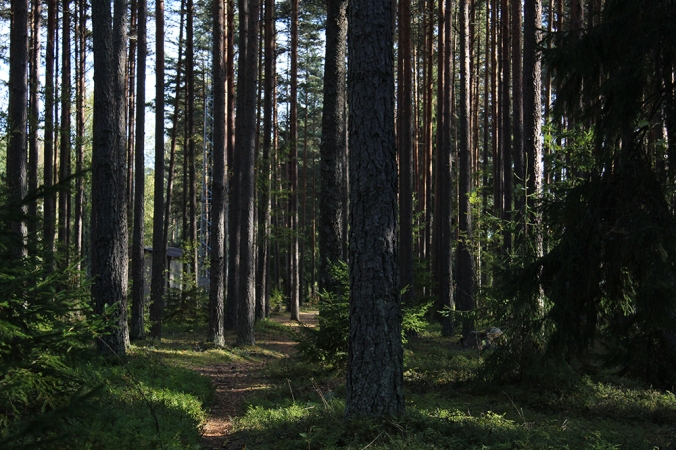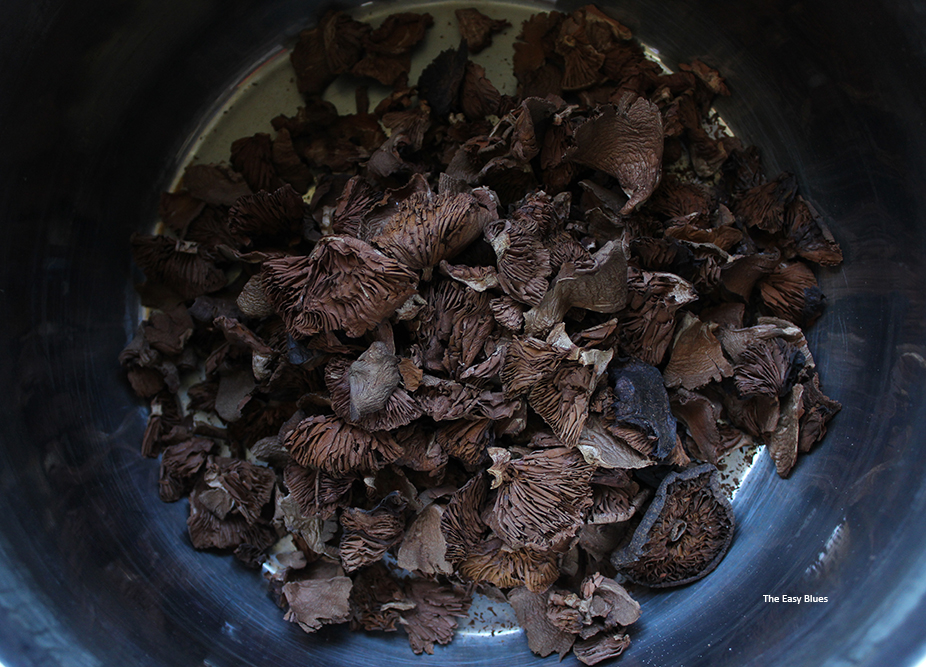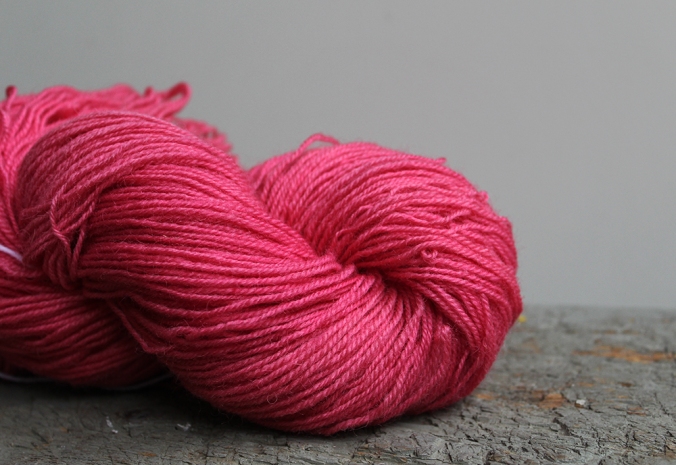There is a one area of natural dyeing that I haven’t tried yet and that is mushroom dyeing. I have never liked eating mushrooms and so I have never been really interested in mushroom picking. Also that is why I’m pretty bad at naming different types of mushrooms. Chanterelle and fly amanita where the ones I knew for sure before my great mushroom adventure.

I have been reading a lot about mushroom dyeing lately and I have been especially interested in different cortinarius species (webcaps). These mushrooms are not edible, in fact most of them are poisonous and some are even lethal but for dyeing they are excellent. In the end of September I packed my bags and traveled to my parents place where there is a lot more forest and asked my dad to show me his best mushroom places. And this is what I found:
Cortinarius semisanguineus (In Finnish: verihelttaseitikki)
This is the bad boy that I most wanted to find. In Finnish its name means “the blood gill webcap” which pretty much sums its appearance up. Wikipedia says that in English it’s called either surprise webcap or red-gilled webcap.

At first it was very difficult to recognize it, but towards the end I got pretty good at spotting it. All webcaps have this little tip at their hat, many of them look similar from above, but when you turn them over you can check from the colour of the gills which one it is. In this case the gills are blood red although they turn more brow when older. The stem is firm and at the bottom it has a hint of red. This red-gilled webcap is an interesting dyeing mushroom because the hat contains red colour and the stem yellow. So you can have two colours from one mushroom or mix them up and make orange! In Finland these mushrooms grow in pine forests and I noticed that I could find more of them from dryer spots.

Cortinarius cinnamomeus (In Finnish. Kanelihelttaseitikki)
I’m pretty sure these mushrooms are cinnamon webcaps. They like to hang out at the same places as the red-gilled webcaps do. They also look very similar to them except for the cinnamon brown colour. They are more common that red-gilled webcaps so I found quite a lot of them. I heard that you are supposed to get brownish colour from them, but either my source is wrong or I didn’t pick the right mushrooms, because I don’t think I got any colour from these. Now I don’t even remember where I read about these.

Cortinarius sanguineus (In Finnish: veriseitikki)
I was so surprised to find these bloodred webcaps. They are named so because they are completely red, you can’t mistake them to anything else . I heard that this has not been a good year for them (too dry) and that they are more common in the more northern parts of Finland than here in the south. And that might be true as I only found seven of them. Mostly they were hiding under fir trees as they like to grow in old fir tree forests. This is amazing webcap, it gives out an amazingly strong colours. Apparently only 33 g of dried bloodred webcap will dye 100 g of yarn and even 5 g will get you a pink colour. Sadly I didn’t find enough of these to have a try.

Cortinarius croseus (In Finnish keltahelttaseitikki)
I also found a few saffron webcaps which have yellow gills. The mushroom is yellowish overall and surprise, surprise you can also get yellow colour from them. I only found a few of these.

I have understood that most of these species are European and some of them grown also in North-America. Correct me if I’m wrong. I mostly found cinnamon webcaps and red-gilled webcaps and I quickly realised, that you need quite a lot of mushrooms for dyeing, several kilograms. Because the mushrooms need to be dried before dyeing the weight decreases considerably. Unfortunately I wasn’t very lucky with the amount of mushrooms I found.
First I chopped the mushrooms into little pieces (the smaller the pieces the quicker they dry) and laid them on newspapers (some kind of airy net would have been better). You can use ovens or boiler rooms or even special vegetable dryers for dryeing but I used a sauna (being Finnish). Apparently you shouldn’t use too hot temperatures, I lifted the temperature to 40 °C and then let the sauna cool off. The mushrooms dried quite quickly over night. I must say though that the smell of the drying mushrooms is not the nicest. In the end I ended up with 26 g of dried red-gilled webcaps together with the few bloodred webcaps I found. I also got 44 g of what I though where cinnamon webcaps.

For dyeing I used a large 10 liter pot. I put the dried webcaps on the bottom and added little water (apparently the colour will dissolve better like this then with lot of water). I boiled the mushrooms for 30 minutes and after that I sifted the mushrooms away from the dye. I added water to the dye so that in the end I had 5 liter of dye. I had some lambswool yarn that I had mordanted with alum and cream of tartar beforehand. I wet that yarn and squished most of the water away and then added the yarn to the dye bath. I put the mushrooms inside old tights (pantyhose) and added them also to the dye. I used thighs so that the mushrooms would not be in direct contact with the yarn and make the colour uneven. I kept the temperature below 80 °C and kept moving the yarn every once in a while for one hour.

This is the colour that I got from the red-gilled webcaps, 26 g of them dyed 100 g of lambswool. I really really love this colour and I think its gorgeous. Very similar to the yarn I dyed with beetroot.

The cinnamon webcaps didn’t work so well. I did exactly the same thing with them, but I noticed that I wasn’t getting any colour out of them so I added to the dye the leftovers from the red-gilled webcap dye. I think that is where the most of the colour really came from.

Most of the information I found about mushroom dyeing I got from a Finnish mushroom dyeing book (Sienivärjäys) written by Anna-Karoliina Tetri. She has an online shop where she sells all kinds of things you need for natural dyeing and she has written several books on the subject (in Finnish). I met her briefly last spring before my natural dyeing adventures started and her shop is where I bought the alum and stuff to get started with all of this. Visit her web shop Tetri Design here.

I feel like I might need to point out one thing. I know that there are people from all around the world who read my blog and I have understood that in some countries it’s illegal to do mushroom picking or it’s regulated. However in Finland and other Scandinavian countries as well as Baltic countries we have a thing called “every man’s right” or “freedom to roam”.
In Finland this means that it is every man’s (or woman’s) right to walk, ski or camp in nature as long as you don’t disturb people or destroy nature. You are also allowed to pick berries and mushrooms as long as they are not protected species. I’m now talking about both public and privet forests and also National parks with the exception or protected lands. It’s prohibited to collect moss or lichen without permission from the owner though. I mention this because I wanted to make sure my mushroom picking is all right and actually very popular hobby in Finland. The best thing about mushroom dyeing was the part were I walked in the forest, enjoyed the nature and found places I otherwise would have never found.







































